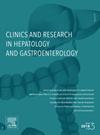一项法国筛查活动的结果,比较间隔期结直肠癌和使用愈创木试验检测的癌症的临床和分子特征。
IF 2.4
4区 医学
Q2 GASTROENTEROLOGY & HEPATOLOGY
Clinics and research in hepatology and gastroenterology
Pub Date : 2025-09-01
DOI:10.1016/j.clinre.2025.102678
引用次数: 0
摘要
很少有研究分析间隔期结直肠癌(CRC)在筛查过程中的生物学特征。我们纳入了98例患者,其中46例为筛查性癌症(SCG), 52例为间隔期癌症(ICG)。微卫星不稳定性和基因突变分析分别对86例和55例患者进行。ICG诊断为更晚期的疾病。在ICG中,最后一次阴性检测与CRC诊断(TIg2D)之间的时间间隔≥18个月与诊断时转移风险增加相关。年龄、男性、直肠癌和TIg2D≥18个月与ICG预后较差相关。在调整后的Cox模型中,间隔期癌症仍然与较差的生存率相关。SCG和ICG的突变频率无显著差异。然而,APC /CTNNB1突变在ICG直肠癌中较少发生。此外,当诊断年龄低于65岁或患者患有结肠癌时,ICG中KRAS激活突变的频率较低。与SCG相比,野生型KRAS患者的ICG生存率明显较差。这些结果表明,男性和老年人可以从每年的筛查中受益。直肠癌患者和野生型APC/CTNNB1/KRAS应视为高危人群。本文章由计算机程序翻译,如有差异,请以英文原文为准。
Results of a French screening campaign comparing clinical and molecular characteristics of interval colorectal cancers to cancers detected using a guaiac test
Few studies have analyzed the biological characteristics of interval colorectal cancers (CRC) during a screening campaign. We included 98 patients of whom 46 had a screened cancer (SCG) and 52 an interval cancer (ICG). Microsatellite instability and gene mutation profiling were performed in 86 and 55 patients, respectively. ICG were diagnosed with more advanced diseases. A time interval between last negative test and CRC diagnosis (TIg2D) ≥ 18 months, in the ICG, was associated with an increased risk of metastasis at diagnosis. Old age, male gender, rectal cancer and TIg2D ≥ 18 months were associated with a worse outcome in ICG. Interval cancers remained associated with a worse survival in an adjusted Cox model. There was no significant difference in terms of mutation frequency between SCG and ICG. However, APC / CTNNB1 mutations were less frequent in rectum cancers of ICG. Furthermore, KRAS activating mutations were less frequent in the ICG when age at diagnosis was below 65 years or if patients had colon cancer. When compared to the SCG, the survival of ICG was significantly worse in patients with wild-type KRAS. These results suggest that men and elderly subjects could benefit from annual screening. Patients with rectum cancer and wild-type APC/CTNNB1/KRAS should be considered as high-risk subjects.
求助全文
通过发布文献求助,成功后即可免费获取论文全文。
去求助
来源期刊

Clinics and research in hepatology and gastroenterology
GASTROENTEROLOGY & HEPATOLOGY-
CiteScore
4.30
自引率
3.70%
发文量
198
审稿时长
42 days
期刊介绍:
Clinics and Research in Hepatology and Gastroenterology publishes high-quality original research papers in the field of hepatology and gastroenterology. The editors put the accent on rapid communication of new research and clinical developments and so called "hot topic" issues. Following a clear Editorial line, besides original articles and case reports, each issue features editorials, commentaries and reviews. The journal encourages research and discussion between all those involved in the specialty on an international level. All articles are peer reviewed by international experts, the articles in press are online and indexed in the international databases (Current Contents, Pubmed, Scopus, Science Direct).
Clinics and Research in Hepatology and Gastroenterology is a subscription journal (with optional open access), which allows you to publish your research without any cost to you (unless you proactively chose the open access option). Your article will be available to all researchers around the globe whose institution has a subscription to the journal.
 求助内容:
求助内容: 应助结果提醒方式:
应助结果提醒方式:


